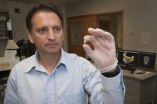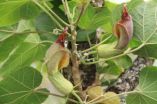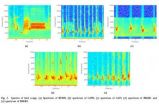(Press-News.org) Since Alexandre Edmond Becquerel first discovered the photovoltaic effect in 1839, humankind has sought to further understand and harness the power of sunlight for its own purposes. In a new research report published in the August 2014 issue of the FASEB Journal, scientists may have uncovered a new method of exploiting the power of sunlight by focusing on a naturally occurring combination of lipids that have been strikingly conserved throughout evolution. This conservation—or persistence over time and across species—suggests that this specific natural combination of lipids is important for ensuring light capture and conversion.
"We confirmed the properties of individual thylakoid galactoglycerolipid (or glycolipid) classes previously reports as HII forming lipids, but brought to light how these properties are subtly orchestrated in the matrix in which proteins are embedded, as contributing components for the elaboration of the architecture of photosynthetic membranes and its dynamics," said Juliette Jouhet, Ph.D., a researcher involved in the work from the Laboratoire de Physiologie Cellulaire and Vegetale at the Institut de Recherches en Technologies et Sciences pour le Vivant in Grenoble, France.
To make this discovery, Jouhet and colleagues analyzed biomimetic membranes reconstructed with different mixtures of natural lipids, so as to comprehend the contribution of each one of them in the observed biophysical properties. They then analyzed the membranes by neutron diffraction methods. The cohesion between membranes was analyzed by the evolution of the distance between bilayers upon hydration.
"This report helps fulfill the hope of Jimmy Stewart's character, Tony, in 'You Can't Take it with You,'" said Gerald Weissmann, M.D., Editor-in-Chief of the FASEB Journal. "Just as he once dreamt of harnessing the process by which grass derives energy from the sun, this report helps us do just that by defining the green engines in plants and higher organisms that accomplish the task."
INFORMATION:
Receive monthly highlights from the FASEB Journal by e-mail. Sign up at http://www.faseb.org/fjupdate.aspx. The FASEB Journal is published by the Federation of the American Societies for Experimental Biology (FASEB). It is the world's most cited biology journal according to the Institute for Scientific Information and has been recognized by the Special Libraries Association as one of the top 100 most influential biomedical journals of the past century.
FASEB is composed of 27 societies with more than 120,000 members, making it the largest coalition of biomedical research associations in the United States. Our mission is to advance health and welfare by promoting progress and education in biological and biomedical sciences through service to our member societies and collaborative advocacy.
Details: Bruno Demé, Céline Cataye, Maryse A. Block, Eric Maréchal, and Juliette Jouhet
Contribution of galactoglycerolipids to the 3-dimensional architecture of thylakoids
FASEB J. August 2014 28:3373-3383; doi:10.1096/fj.13-247395 ; http://www.fasebj.org/content/28/8/3373.abstract
Scientists shine bright new light on how living things capture energy from the sun
New research in the FASEB Journal suggests that a specific combination of lipids contributes to how living creatures capture sunlight and convert it into energy
2014-07-31
ELSE PRESS RELEASES FROM THIS DATE:
Misinformation diffusing online
2014-07-31
The spread of misinformation through online social networks is becoming an increasingly worrying problem. Researchers in India have now modeled how such fictions and diffuse through those networks. They described details of their research and the taxonomy that could help those who run, regulate and use online social networks better understand how to slow or even prevent the spread of misinformation to the wider public.
Krishna Kumar and G. Geethakumari of the Department of Computer Science and Information Systems, at BITS-Pilani, Hyderabad Campus, in Andhra Pradesh, India, ...
Lead in teeth can tell a body's tale, UF study finds
2014-07-31
GAINESVILLE, Fla. – Your teeth can tell stories about you, and not just that you always forget to floss.
A study led by University of Florida geology researcher George D. Kamenov showed that trace amounts of lead in modern and historical human teeth can give clues about where they came from. The paper will be published in the August issue of Science of The Total Environment.
The discovery could help police solve cold cases, Kamenov said. For instance, if an unidentified decomposed body is found, testing the lead in the teeth could immediately help focus the investigation ...
Scientists discover biochemical mechanisms contributing to fibromuscular dysplasia
2014-07-31
An important step has been made to help better identify and treat those with fibromuscular dysplasia (FMD). FMD causes both an abnormal narrowing and enlarging of medium sized arteries in the body, which can restrict blood flow to the kidneys and other organs causing damage. In a new report appearing in August 2014 issue of The FASEB Journal, scientists provide evidence that that FMD may not be limited to the arteries as currently believed. In addition, they show a connection to abnormalities of bones and joints, as well as evidence that inflammation may be driving the ...
New paper describes how DNA avoids damage from UV light
2014-07-31
BOZEMAN, Mont. – In the same week that the U.S. surgeon general issued a 101-page report about the dangers of skin cancer, researchers at Montana State University published a paper breaking new ground on how DNA – the genetic code in every cell – responds when exposed to ultraviolet (UV) light.
The findings advance fundamental understanding of DNA damage by the UV rays found in sunlight. This damage can lead to skin cancer, aging and some degenerative eye diseases.
"Our paper advances foundational knowledge about how DNA responds to UV radiation. In our experiments, ...
Magnetic resonance imaging in patients with transient ischemic attack
2014-07-31
Transient ischemic attack (TIA) is a temporary event, which portends a higher risk of a disabling stroke following the TIA. However, the evaluation and management of TIA vary worldwide and is debated and controversial. Dr. Mohamed Al-Khaled from University of Lübeck in Germany considered With the development of brain imaging, particularly diffusion weighted imaging-magnetic resonance imaging (DWI-MRI), the diagnosis of TIA changed from time-based definition to a tissue-based one. DWI-MRI became a mandatory tool in the TIA workup. The DWI-MRI provides not only the evidence ...
Ligaments disruption: A new perspective in the prognosis of SCI
2014-07-31
Worldwide prevalence of Spinal Cord Injury (SCI) is ranging from 233 to 755 per million inhabitants, whereas reported incidence lies between 10.4 and 83 per million inhabitants per year. Thus, the socioeconomic impact of SCI associated with cervical trauma is high enough to be encountered within one of the most important worries in vast majority of developed countries.
The ability to predict recovery following SCI is of paramount importance to the physician's role in providing the best care and guidance to patients and families during the illness. Diagnosis of cervical ...
Brother of Hibiscus is found alive and well on Maui
2014-07-31
Most people are familiar with Hibiscus flowers- they are an iconic symbol of tropical resorts worldwide where they are commonly planted in the landscape. Some, like Hawaii's State Flower- Hibiscus brackenridgei- are endangered species.
Only a relatively few botanists and Hawaiian conservation workers, however, are aware of an equally beautiful and intriguing related group of plants known as Hibiscadelphus- literally "brother of Hibiscus".
Brother of Hibiscus species are in fact highly endangered. Until recently only one of the seven previously known species remained ...
Singing the same tune: Scientists develop novel ways of separating birdsong sources
2014-07-31
Researchers at the University of California, Los Angeles and the Chinese Academy of Sciences have pioneered a new study that could greatly improve current methods of localising birdsong data. Their findings, which ascertain the validity of using statistical algorithms to detect multiple-source signals in real time and in three-dimensional space, are of especial significance to modern warfare.
Recently published in the journal Unmanned Systems, the study demonstrates the validity of using approximate maximum likelihood (AML) algorithms to determine the direction of arrival ...
Gulf oil spill researcher: Bacteria ate some toxins, but worst remain
2014-07-31
TALLAHASSEE, Fla. — A Florida State University researcher found that bacteria in the Gulf of Mexico consumed many of the toxic components of the oil released during the Deepwater Horizon spill in the months after the spill, but not the most toxic contaminants.
In two new studies conducted in a deep sea plume, Assistant Professor Olivia Mason found a species of bacteria called Colwellia likely consumed gaseous hydrocarbons and perhaps benzene, toluene, ethylbenzene and xylene compounds that were released as part of the oil spill.
But, her research also showed that bacteria ...
Hope for the overweight
2014-07-31
White, brown and beige adipocytes, or fat cells, are inherently different. Each of these cell types has different functions and each plays its own role in metabolism. In the human body, white adipose tissue is by far the most prevalent. Its primary function is energy storage. On the other hand, brown adipocytes utilize available energy to generate heat but are only found in a few places in the adult human body. Beige adipocytes, which represent a special type of brown adipocytes, appear mixed with brown adipocytes in human brown adipose tissue or develop within the white ...
LAST 30 PRESS RELEASES:
Strategic river sensors could have forewarned of Texas Camp flood disaster
Drone sampling of whale breath reveals first evidence of potentially deadly virus in Arctic
Roman soldiers defending Hadrian’s Wall infected by parasites, study finds
Pinochet’s prisoners were tormented with music but still found solace in it, a new book reveals
Fertility remains high in rural Tanzania despite access to family planning
AI-assisted device can improve autism care access
Kinetic careers
Uncovering how parasitic plants avoid attacking themselves to improve crop resistance
Nanoparticle vaccine strategy could protect against Ebola and other deadly filoviruses
Study finds brain care score can predict risk of stroke across racial groups
Key lung immune cells can intensify allergic reactions
Do hormones explain why women experience more gut pain?
New materials conduct ions in solids as easily as in liquids
Breakthrough of the Year: Renewable energy begins to eclipse fossil fuel-based sources
LLM use is reshaping scientific enterprise by increasing output, reducing quality and more
Introducing LightGen, a chip for ultra-fast, ultra-efficient generative AI
Astronomers see fireworks from violent collisions around nearby star
ACC/AHA issue new guideline on managing congenital heart disease in adults
Cosmic crash caught on camera
Is talented youth nurtured the wrong way? New study shows: top performers develop differently than assumed
Ants: An untapped resource in the development of antibiotics?
Archaeologists use AI to create prehistoric video game
Mitochondria migrate toward the cell membrane in response to high glucose levels
Tiny viral switch offers hope against drug-resistant bacteria
Most parents aware of early peanut introduction guidelines, but confused about details
HPV vaccine can protect against severe lesions of the vulva and vagina
Virtual care provision and emergency department use among children and youth
Quadrivalent HPV vaccine and high-grade vulvovaginal lesions
Insights into dry eyes gained from stem cell-derived tear glands
Researchers identify 166 human pluripotent stem cell lines available for use in clinical applications
[Press-News.org] Scientists shine bright new light on how living things capture energy from the sunNew research in the FASEB Journal suggests that a specific combination of lipids contributes to how living creatures capture sunlight and convert it into energy


